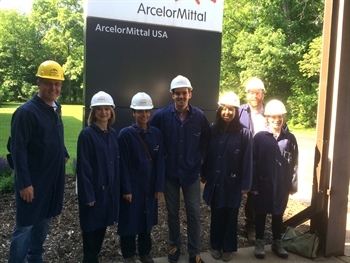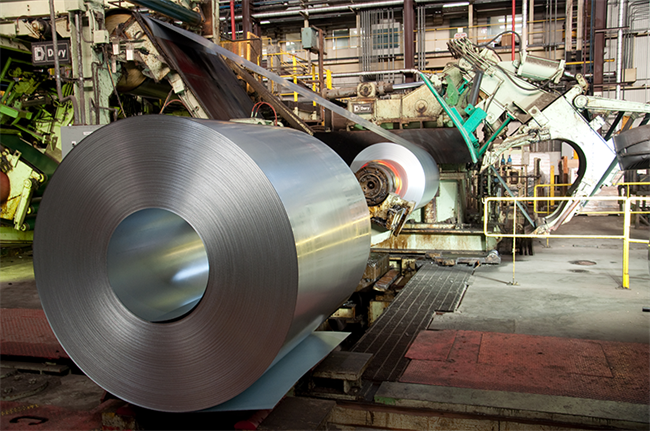
Photo courtesy of Arcelor Mittal
Steel, heated to between 1800 and 2400 degrees Fahrenheit, is stretched into long rolls using water pressure.
On Monday, June 9, a few of us here at Metropolitan Planning Council (MPC) headed out to the ArcelorMittal steel plant at Burns Harbor, Ind.:
ArcelorMittal's second largest USA facility, Burns Harbor, is a fully integrated steelmaking facility located on Lake Michigan in Northwest Indiana, 50 miles southeast of Chicago.
The location allows for prime shipping access to the Port of Indiana – Burns Harbor, as well as excellent highway and railroad transport. It is the only steelmaking facility in the U.S. that is bordered on two sides by a national park. The plant operates two blast furnaces and is capable of producing 5 million tons of raw steel annually.
One of the parts of the tour we got most excited about was the Hot Roll process, where slabs of steel 10 inches thick are heated to 2300°F and then reduced to a coil of steel 2000 feet long. Then they are rolled as you'll see in the photo below.
We all agreed we could stand around watching the process happen all day. It looked like a car wash, in a way: steel slabs on a long, long, long set of rollers, passing through periodic blasts of water from above that flatten them out, little by little. The steel is so hot that from over 50 feet away the temperature is still near 120 degrees. As the steel passed by on its roller-powered conveyor belt, we could feel the heat wash over us like a wave. Then the steel would pass and the temperature would drop back down to normal. It was just one piece of a pretty cool day for all of us.
Here's what staff members had to say about our outing:
I took away two things from the visit, and neither was really about steel. First, I personally have worked with the team from ArcelorMittal on issues of land conservation and economic development in and around the Indiana Dunes National Lakeshore, which is just up the beach… and down for that matter. ArcelorMittal is literally surrounded by federal and state protected land. I have always been impressed by their commitment to that landscape and waterscape and introducing it to the world. They are in constant dialogue with the National Lakeshore about land use and land holdings, and constantly engaging in stewardship activities.
Some of that may stem from the second thing I took away: Everybody seems to live right down the street. I asked several employees how far their commute was, and almost everyone said between 10 and 20 minutes, which means all their homes are in close proximity to Lake Michigan and the National Lakeshore as well. I recognize the tension inherent in being a steel mill in the middle of conservation lands, and the relationship isn’t perfect, but the combination of the work, the people and the place was striking. That’s the potential of place-based anchor institutions. It just so happens that these guys make the raw materials for actual anchors too.
"Since the Burns Harbor plant produces an enormous share of the nation’s steel, the operations are contingent on a highly developed, well-organized logistics operation—particularly for rail freight. But the staff with whom we spoke noted that the Chicago rail hub, even with recent CREATE improvements, remains a significant obstacle to timely delivery of steel to customers. It is clear that more investment in the hub is necessary to guarantee efficient freight transportation in the region for many of the area’s largest employers, including companies like ArcelorMittal."
Often, people do not think about how involved the process is to make seemingly simple everyday items we use on a daily basis, like our steel frying pans. But during the first part of our Arcelor Mittal field trip to Arcelor Mittal, I was struck by how intricate and complex steel making is. Think about it. Through heating, Arcelor Mittal transforms rusty, brown iron ore into shiny, silvery steel. Before we can even get to the steel making, though, first the company transforms metallurgical coal into coke—driving off impurities through heating to 2,300°F degrees to produce almost pure carbon. Coke is considered essential to steelmaking given its ability to burn steadily and reliably, producing less smoke than coal.

From left to right: William Steers, ArcelorMittal with MPC staffers Nancy Firfer, Christina Harris, Yonah Freemark, Abby Crisostomo, Josh Ellis and Ariel Ranieri
Before going to see a steel plant, I knew industries were major users of water, but it was amazing to see just how much clean water is integrated into every step of the manufacturing process—515 million gallons a day are used at ArcelorMittal, though approximately 80 percent is returned back to Lake Michigan cleaner than it started. Everything from cooling hot slabs of metal to cutting slabs to the right size to even shipping the raw and finished goods to and from Burns Harbor—it’s no wonder ArcelorMittal invests in water policy and research through funds like Sustain our Great Lakes and the Chi-Cal Rivers Fund (RFP came out last week!).
With the water-energy nexus in mind, it was nice to see, too, how they’ve invested in energy efficiency, acknowledging that it’s the little improvements—such as replacing light bulbs and installing variable switches—that have provided them major energy savings. To improve the experience of industries like this and promote economic development, I’d be curious to see what efforts could be done to make improvements in water efficiency, and also to acknowledge what the Chicago region does have to offer for other water-dependent industries.
I had zero idea what to expect at a steel mill, but one of the things that stuck out to me was the delicate relationship between ArcelorMittal and Lake Michigan—and not just because of ArcelorMittal's effects on the lake, but the opposite as well. For example, ArcelorMittal almost had to shut off their blast furnaces at Burns Harbor this winter because the weather was so bad for so long. Because iron ore, the main ingredient in steel, can only be efficiently transported by boat, they stockpile it during the warmer months and then hope they have enough for the winter. This winter, they almost ran out. Even in 2014, our economy is impacted by the weather. That's something to think about as the effects of climate change intensify in the coming years.
Curious to learn more about the process? Check out ArcelorMittal's in-depth video here.

Rolls of steel that were previously blocks (as pictured in the photo at top).
ArcelorMittal

ArcelorMittal